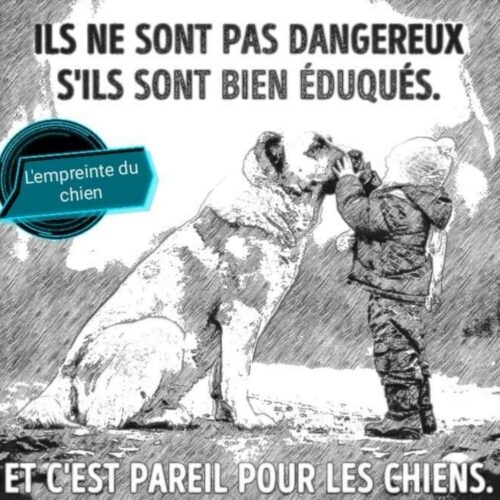



III – The basis of dog communication
Canine codes are part of a puppy’s training from the first weeks of life.
Knowing them will improve the relationship with your puppy. Understanding them, and making ourselves understand them through their own codes, strengthens the complicity with them.
Our dogs often look at us. And their senses, especially their sense of smell, which is much more developed than ours, enable them to understand us quickly and easily.
We transmit our emotions through smells thanks to the sweat glands ![]() , and through certain hormones and pheromones
, and through certain hormones and pheromones ![]() .
.
Our dogs feel them, and sometimes know how to analyse before we do what physical or emotional state we are in.
They also learn to detect our state according to our attitudes, gestures, expressions, but also by our intonations.
IV – What if we understood our dog?
1 – Understanding your dog :
Understanding him allows us to give him all the well-being we want for him.
To respect its basic needs (the social need, the need for physical exercise, the need formental stimulation, the need to chew, the need for speech, and the need for reproduction).
These are necessary for the physical and emotional health of the dog.
2 – Making your dog understand you:
Knowing his language allows us to communicate with him using codes that he already knows in order to facilitate the human-dog relationship.
For example, when the dog looks at us when he is a little stressed, we can indicate that the situation is normal and calm by gently squinting, yawning, turning his head away.
When the dog reproduces some of these signals, such as yawning, it helps to relax the dog and proves that the communication is well established and understood.
3 – Understanding interactions with fellow dogs:
When dogs interact, it is important to be aware of dog codes and calming signals. This makes it possible to realise the relationship between the dogs and to prevent certain behaviours.
4 – Understand its interactions with other animals:
Dogs and cats can get along very well (which is the case with me). They must learn to understand each other. Basically, they do not have the same communication codes.
5 – Observe your dog
which interacts with animals other than its own species, makes it possible to identify its emotions and intentions.
- Knowing how to detect your dog’s emotional states: emotions can be rather playful, playful, cuddly or not at all. Some are confident, and others may be afraid of things we can’t even see, because they will have heard a noise we can’t hear. Knowing the canine codes and calming signals will help us identify our dog’s discomfort when faced with an uncomfortable situation. This will allow us to put the dog in a place where it will feel more comfortable.
- Avoiding reinforcing certain behaviours: understanding your dog can help you avoid certain behavioural problems. Through lack of knowledge, the human may indeed validate and therefore reinforce certain behaviours of the dog, which will lead to behavioural problems. For example: petting a dog that is afraid will only reinforce that fear. Indeed, by stroking the dog, the keeper “validates” the dog’s fear by involuntarily telling him “yes, you are right to be afraid, come on, I’ll reassure you”. This can lead to growing fears, such as fear of firecrackers, or fear of an individual, canine or human.

L’empreinte du chien – Facebook



Link to learn more
I invite you to go to the site D’clickBnb. – travel with your dog.
Maorie D’clickBnb talks about the dog’s senses.


